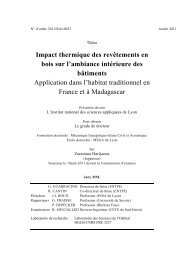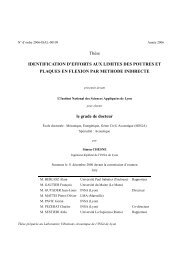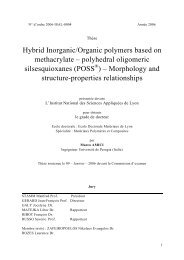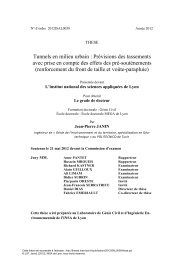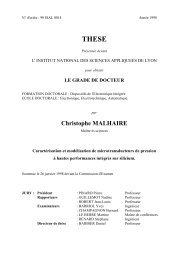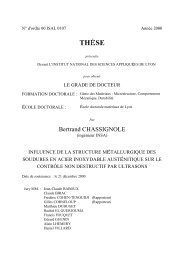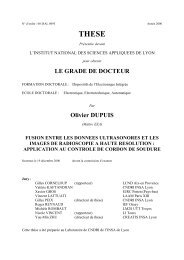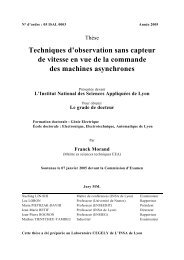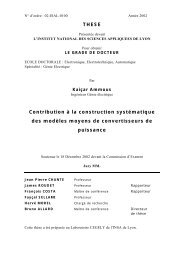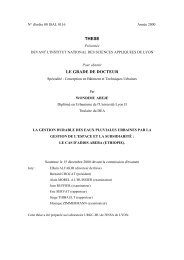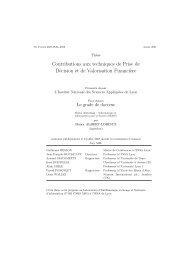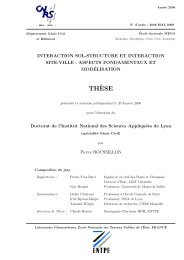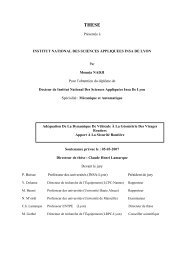Etude biochimique et nutritionnelle de l'effet immunomodulateur des ...
Etude biochimique et nutritionnelle de l'effet immunomodulateur des ...
Etude biochimique et nutritionnelle de l'effet immunomodulateur des ...
Create successful ePaper yourself
Turn your PDF publications into a flip-book with our unique Google optimized e-Paper software.
II-2-2 La réaction d’hydrolyse catalysée par la PLD...................................................... 48<br />
II-2-3 Mesure <strong>de</strong> l’activité PLD....................................................................................... 50<br />
II-2-4 Clonage <strong>et</strong> caractérisation <strong>de</strong> la PLD ................................................................... 51<br />
II-2-5 Structure <strong>de</strong> la PLD ............................................................................................... 52<br />
II-2-5-1 Motifs HKD <strong>et</strong> mécanisme catalytique .......................................................... 52<br />
II-2-5-2 Les régions conservées I <strong>et</strong> III (CRI <strong>et</strong> CRIII) ............................................... 53<br />
II-2-5-3 Les domaines PH <strong>et</strong> PX.................................................................................. 55<br />
II-2-5-4 Les régions amino <strong>et</strong> carboxy-terminales....................................................... 55<br />
II-2-5-5 La boucle centrale <strong>de</strong> PLD1 ........................................................................... 56<br />
II-2-6 Régulation <strong>de</strong> la PLD............................................................................................. 56<br />
II-2-6-1 Régulation par le phosphatidylinositol-4, 5-biphosphate (PIP2).................... 58<br />
II-2-6-2 Les protéines G monomériques ..................................................................... 58<br />
II-2-6-2-1 Régulation par les protéines ARF « ADP-Ribosylation Factor » ........... 59<br />
II-2-6-2-2 Régulation par les protéines Rho ............................................................ 60<br />
II-2-6-3 Régulation par les protéines kinases C (PKC)................................................ 60<br />
II-2-6-4 Régulation par les tyrosines kinases............................................................... 62<br />
II-2-6-5 Régulation par le calcium (Ca 2+ ) .................................................................... 62<br />
II-2-6-6 Régulation par <strong>de</strong>s facteurs inhibiteurs .......................................................... 62<br />
II-2-7 Localisation <strong>de</strong>s PLD............................................................................................. 63<br />
II-2-7-1 Localisation tissulaire..................................................................................... 63<br />
II-2-7-2 Localisation subcellulaire............................................................................... 64<br />
II-2-8 Rôles physiologiques <strong>de</strong> la PLD ............................................................................ 66<br />
II-2-8-1 PLD <strong>et</strong> prolifération cellulaire........................................................................ 67<br />
II-3 ACIDES GRAS ET IMMUNITE............................................................................................ 68<br />
II-3-1 Généralités............................................................................................................. 68<br />
II-3-2 Nomenclature <strong>de</strong>s AG ........................................................................................... 69<br />
II-3-3 Les aci<strong>de</strong>s gras essentiels (AGE)........................................................................... 71<br />
II-3-4 Rôle biologique <strong>de</strong>s AG: ........................................................................................ 71<br />
II-3-4-1 Rôle énergétique:............................................................................................ 71<br />
II-3-4-2 Rôle structural: ............................................................................................... 71<br />
II-3-4-3 Rôle fonctionnel ............................................................................................. 73<br />
II-3-4-3-1 Synthèse <strong>de</strong>s eicosanoï<strong>de</strong>s....................................................................... 73<br />
II-3-4-3-2 Régulation <strong>de</strong> la transmission membranaire du signal :.......................... 74<br />
II-3-5 Sources habituelles <strong>de</strong>s AGE <strong>et</strong> <strong>de</strong> l’aci<strong>de</strong> oléique............................................... 74<br />
14



